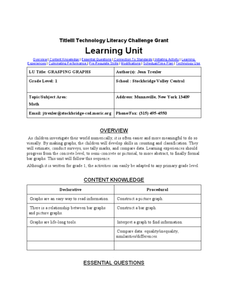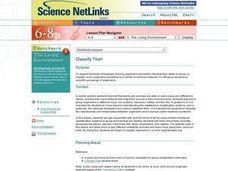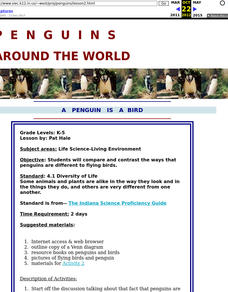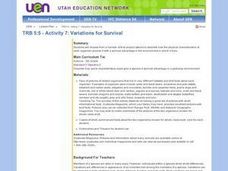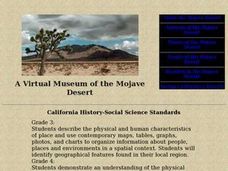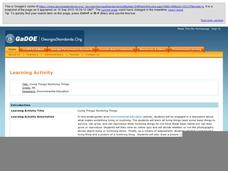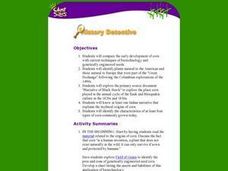Curated OER
Which Herp Is Which?
Students research different kinds of herps. The teacher gives the student a particular herp and the student writes a postcard (as the herp) to an in-class penpal, giving hints about the herp, but not identifying itself.
Curated OER
Technology Literacy Challenge Grant Learning Unit
First graders explore counting and classification. They sort leaves, create graphs, write sentences for the data in the graphs, develop graphs for shapes, favorite animals, birthdays, and participate in a die prediction game.
Curated OER
Making Mittens with The Mitten Book
Students read and discuss the different animals in The Mitten book and then try to make mittens that are alike.
Curated OER
Classify That!
Learners explore diverse forms of life by using modern biological classification systems to group animals that are related. Students then study basic scientific groupings like genus, species, mammals, fish, birds, amphibians, and...
Curated OER
Classify That!
Students get acquainted with diverse forms of life by using modern biological classification systems to group animals that are related. They explore basic scientific groupings like genus, species, mammals, fish, birds, amphibians, and...
Curated OER
Treetures
Students identify the different forests of the world and some of the characteristics that differentiate them. They explore old magazines, calendars and photos and fill out a scavenger hunt worksheet.
Curated OER
A Penguin is a Bird
Students compare and contrast the ways that penguins are different to flying birds.
Curated OER
Variations for Survival
Fifth graders examine two related organisms that live in different environments and compare how the physical characteristics of each organism provided it with survival advantages unique to its own environment.
Curated OER
A Virtual Museum of the Mojave Desert
Students study deserts and the plants, animals, and people who inhabit them. In groups, they create their own stories about the inhabitants of the Mojave desert.
Curated OER
Architecture : A Reflection of Our Times
Students explore types of architecture and how it has changed throughout history. They predict what homes of the future may look like. Students investigate a variety of well known architects from around the world and from different...
Curated OER
IDENTIFYING AND SORTING BEARS
Students study the difference between living and nonliving bears by classifying pictures of bears and placing them on the appropriate posterboard. Given pictures of bears, students recognize types of bears by placing the pictures correctly.
Curated OER
The Plant and Animal Walk
Students draw pictures and write words to describe objects and experiences. They observe outside and draw at least three animals and three plants. Students observe plants and animals describing how they are alike and how they are...
Curated OER
Breed Twins-Dog Breeds
In this online quiz worksheet, students answer a set of trivia questions about dog breeds. The page has a link to submit answers for review.
Curated OER
Mongolia Geography
Students examine the geography and culture of Mongolia. Individually, they cut out cut-outs of animals to place on their maps and label the grasslands and desert areas. They locate major cities and rivers along with vegetation.
Curated OER
Dromedary and Bactrian Venn Diagram
In this camel Venn Diagram worksheet, students compare dromedary and Bactrian camels by completing the Venn Diagram for the animals.
Georgia Department of Education
Living Things/ Nonliving Things
How can you tell if something is living or nonliving? Introduce a set of criteria which can be used to determine which things are alive and which are not. The class discusses the basic needs of all living organisms, checks out an...
Curated OER
Plant Parts
Little ones identify the parts of a plant and practice following directions at the same time. They color each part of the flowering plant the color indicated on the sheet. Roots are brown, leaves are green, the flower is red, and the...
Curated OER
Dinosaurs 1: Where are the Dinosaurs?
Students investigate world history by creating a diorama in class. In this dinosaur extinction lesson, students read assigned text discussing the time frame of the dinosaurs residence on Earth and their eventual demise. Students recreate...
K12 Reader
In Danger of Extinction
What happens when a species becomes extinct? Sharpen your reading skills with a passage about how koalas have gotten close to being an endangered species.
New South Wales Department of Education
Plant Features
Pine needles are actually modified leaves. In the 16th installment of 20, young scientists explore plants. Through an analysis of leaves — shape, veins, and edges — pupils see how to classify plants based on structural features.
Curated OER
Where Are the Dinosaurs?
Students study dinosaurs by completing two activities and group discussion. In this dinosaur lesson plan, students discuss dinosaurs and extinction as a class. Students make dinosaur dioramas, a hatchable dinosaur egg after watching a...
Curated OER
Science-Introduction to Mammals
Young scholars discover mammals. In this mammals lesson, students examine pictures of mammals and their backbones. Young scholars also feel the backbone of a guinea pig.



